Instant Pot as Community
We continue with our summer blog series “Perspectives from Anthropology of Food” with this post from Laura Kitchings. This series presents work written by the students in the summer Anthropology of Food class (ML 641) in which they reflect on current issues, discuss assignments they have worked on, or address topics of particular interest to them.
My participation in the Anthropology of Food course led me to reflect on my participation in the moderated Facebook group, Instant Pot Community. As of June 25th, 2017, the group had 520,441 members.

For those who don’t know, the Instant Pot (produced by the Instant Pot company) is an electronic multi-cooker that acts as a slow cooker, electric pressure cooker, rice cooker, steamer, yogurt maker, and sauté pan, depending on the chosen setting. It features multiple safety features to calm the fears of those who have memories of explosions caused by earlier generations of pressure cookers. Several models of the Instant Pot are available at kitchen and online retailers at various price points, and many are purchased through third party sellers. Breville, All-Clad, and other companies now produce similar products, but what sets the Instant Pot apart is the company’s focus on the creation and moderation of its Facebook community.
On an average day, posts cover a variety of topics related to cooking in the appliance. Sample posts include: a military wife describing the appliance to her deployed husband, a mother asking for advice on preparing meals for a child recently diagnosed with celiac disease, and a question about how to best cook frozen chicken wings in the appliance. Almost all posts receive a reply from another group member within minutes. Throughout the threads, jokes about being a Pot Head abound, specialized terms such as NR (natural release) and PiP cooking (cooking in another container within the appliance) are used, photographs of customized decals placed on the outside of the appliance are shared, and links to amateur YouTube videos of food preparation using the Instant Pot are shared. Four employees of the company moderate the group and regularly close comment threads for inappropriate content.
In the class we discussed the practice of “doing-cooking” from Luce Giard’s chapter on “Gesture Sequences” in the larger work, The Practice of Everyday Life by Certeau, Giard, and Mayol (1998). In this chapter, Giard discusses how daily cooking involves both the mind and body. She discusses how the mind works to organize, make decisions, improvise, and a host of other activities, while the body mixes, stirs, and performs the actions needed for cooking. For me, this article contextualizes the number of posts from people trying to multi-task while cooking. As shown by Giard, the mind and body are already fully occupied during the process of planning a meal and cooking. People post about being interrupted while cooking to breastfeed their children, about dogs who need to be taken outside, children working on homework, and numerous other daily realities. Members of the Facebook community post about how the Instant Pot allows them to take fewer physical actions during the creation of a meal, and also how the Keep Warm function of the Instant Pot means that even if the dish is finished, it does not need to be eaten immediately. People also post about how the food cooking in the Instant Pot does not need to be monitored (or, as referred to in posts, “Baby-Sat”) while cooking. So the cooks can physically and/or mentally attend to other tasks while the food cooks without a risk of burning or kitchen fire. Other posts share recipes related to a variety of diets, or express budgetary concerns. This assists with the mental decisions needed to create a meal within the dietary needs and budget of the particular household.
In a 2011 article in American Ethnologist, Gagné discusses how urban farmer’s markets serve as a “Third Place.” A “Third Place” typically develops as an accessible space outside of work and home where the regulars have no obligation to spend time. According to Gagné, urban farmer’s markets provide an accommodating location where conversation between regulars is prioritized. Starbucks has also been studied as an example of “Third Place” in an article by En-Yin Lin. In this article, Starbucks provides a comfortable, consistent physical environment for the consumer to construct their personal and social identities, while publically consuming a product that fits their developing idealized view of themselves (Lin 2012).
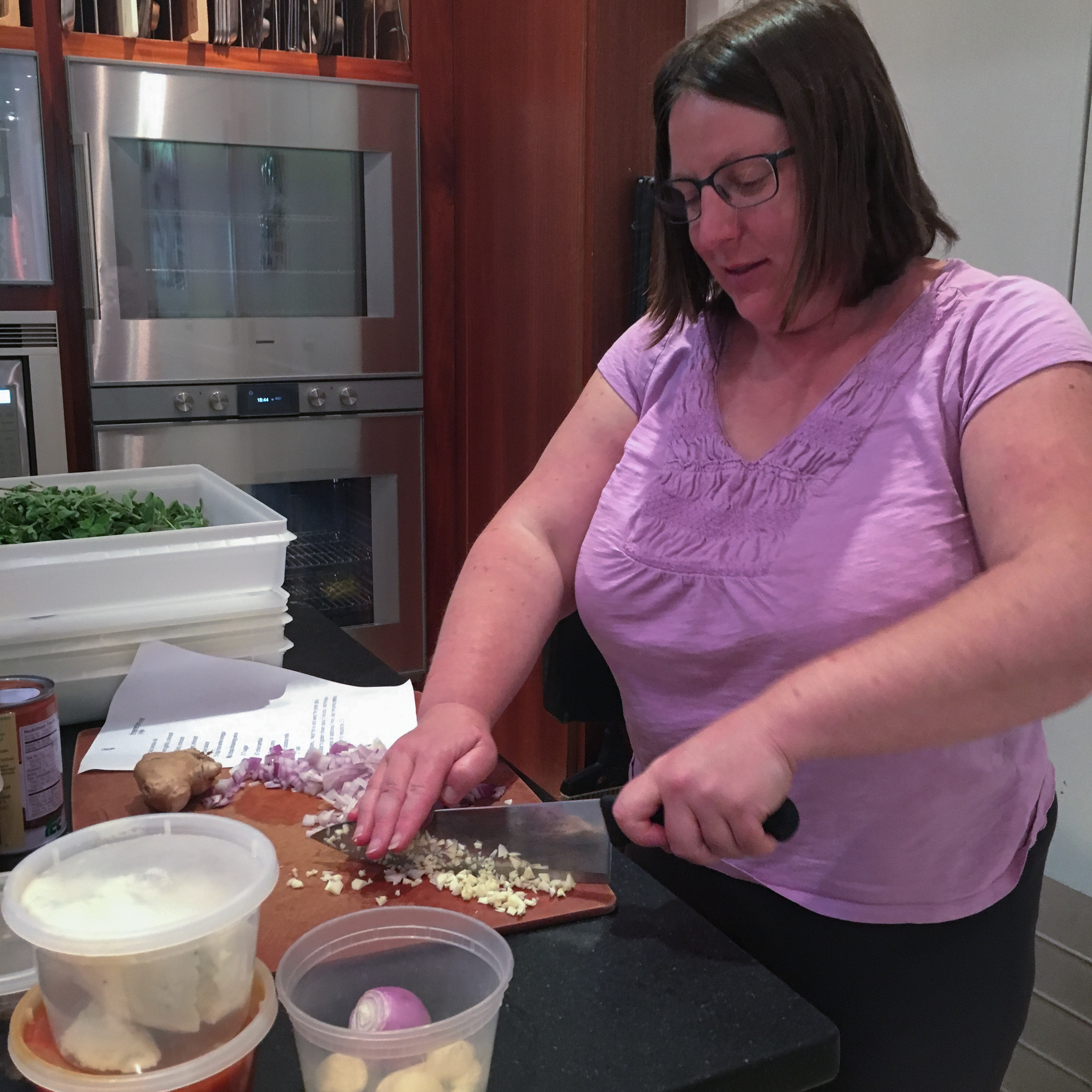
The Facebook group for the Instant Pot acts as an online “Third Place,” one that celebrates the constant ritual of doing cooking. While there is no obligation for participation in the community, the online space allows the participants to showcase and develop their identities. The only requirements of participation are that posts tangentially relate to the Instant Pot and follow the rules set by the moderators. The underlying conversation in the majority of the posts is the challenge of creating meals that meet the nutritional needs of the participant’s households within a budget. Participants also share their frustration that their meal creations are not appreciated by the household, and often find this appreciation in the Facebook group. Like the Farmer’s Markets, the Facebook group often provides its members with a bit of culinary tourism, as individuals may follow threads related to foods that are unfamiliar and are introduced to additional online cooking resources by other members. The Facebook community is similar to the Starbucks experience as the Instant Pot company provides a comfortable, consistent, online environment. In this environment, the participants showcase their developing identities while publically stating their appreciation for an appliance that makes meal preparation easier.
In short, the Instant Pot Facebook Group is an excellent example of “Third Place.” Beneath the day-to-day exchange of information of cooking with this appliance, there is another discourse—one in which users can share their frustration around the day-to-day mental and physical realities of cooking, share advice around meal planning, and publically develop their own individual identities as meal creators.
Refusing Food to Create an Identity
Our summer blog series “Perspectives from Anthropology of Food” presents work written by the students in the summer Anthropology of Food class (ML 641) in which they reflect on current issues, discuss assignments they have worked on, or address topics of particular interest to them. Today’s post is from Emma Herman, a student in the Nutrition Program at Boston University's Sargent College

As a dietetic student I am excited for the opportunity to work with people in modifying their diets for optimal health. After taking Anthropology of Food, I promise to always consider their cultural and familial food consumption habits first. American diet culture has a nasty habit of judging other people’s food choices and idealizing certain food habits over others. Why can’t so and so stop eating the macaroni and eat some kale? The industry has the habit of telling people to stop eating whole food groups without considering what these food items might mean culturally and to focus instead on grams of macronutrients or levels of vitamins.
What a person chooses to eat tells their story. It may imply religious beliefs, personal values, or cultural and ethnic heritage. Telling someone to avoid rice may actually create more issues than it solves. Did this person grow up in a household that considers a meal incomplete without rice? Was their recipe for rice passed down for generations? Does eating a separate meal from their family create a feeling of exclusion? If a person of their own volition chooses to follow a new diet trend, this too is a way of expressing personality and cultural group inclusion. As food trends like the Whole 30 and vegan diets pop up all over my social media page, I realize that this too is a way of telling the world “I belong to this group.” Pledging allegiance to vegan eating or avoiding non-sustainable seafood says who you would like to be, this is a change you are making purposefully, while food avoidances you grew up with, like kosher or halal eating may honor your cultural heritage.

In Eating Animals, Jonathan Safran Foer tells the story of his grandmother who starved during World War II. Towards the end of the war, a Russian Farmer offered her a piece of pork, which she refused. When her grandson questions this choice—“But not even to save your life?”—she answers, “If nothing matters, there’s nothing to save.” When you have nothing else left, you can still choose what you will and will not eat. Her identity as a Jew was strongly tied to her kosher diet; giving that up would have made her feel like her identity had been stripped completely, and she would have nothing left to save (Foer 2009).
Eating is a necessity, and those of us who are lucky get to choose what we eat several times a day. Our food choices reflect who we are, and when stripped of all other identifying features like home and family, you still must eat to survive. Rejecting food while starving might seem strange, but it can be a way of preserving identity when you have nothing else to save.
Works Cited:
Foer, Jonathan Safran. 2009. Eating Animals. Boston: Little, Brown and Company.
An Interview with an American in Benin
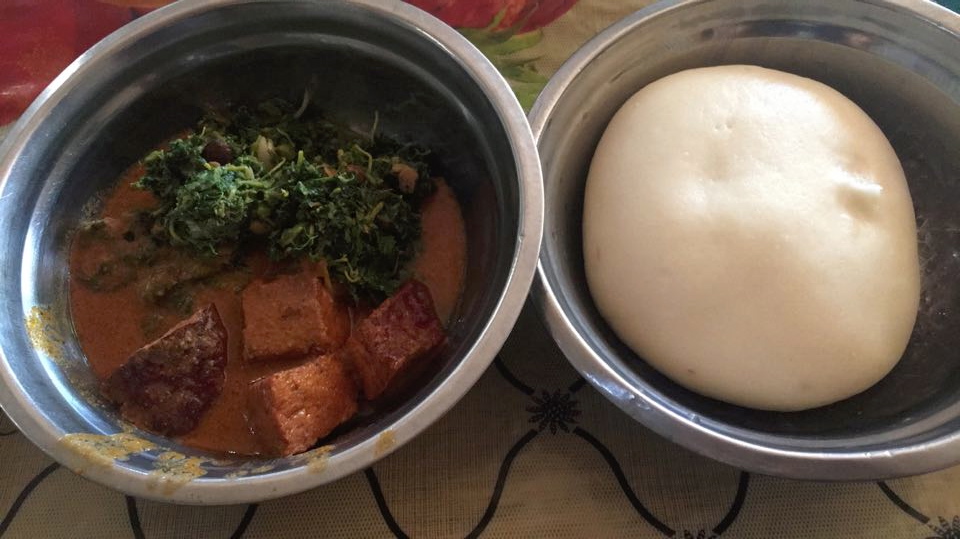
The next entry in our summer blog series “Perspectives from Anthropology of Food” is by Gastronomy student Sydney Manning. This series presents work written by the students in the summer Anthropology of Food class (ML 641) in which they reflect on current issues, discuss assignments they have worked on, or address topics of particular interest to them.
Benin is a small francophone country in West Africa that shares borders with fellow French-speaking Togo, and Nigeria. The population of Benin is close to 11 million, with eight ethnic groups represented, and the two major religions observed in the country are Islam and Roman Catholicism. In writing this blog for my Anthropology of Food class, I knew very little about Benin culture, so I contacted a childhood friend for more information. Andrea*, who graduated with a master’s degree in business with additional studies in anthropology, was born and raised in the midwestern United States, and is now a community economic development specialist in the Peace Corps stationed in Benin. She was initially assigned to service in Mali but due to an uptick in terrorism, she was offered a position in Benin, where she has been living and working since January 2016. Because Andrea is American and comes from an anthropological background, I was curious to learn about her observations as a contributing member of Benin society as they relate to food.
Going into this interview, I first wanted to know Andrea’s food expectations about Benin. What was she expecting? Was she worried there would be no comforts of home? “I didn't

come expecting to eat American food, whatever ‘American food’ is,” she said. “I was expecting [the food] to be like Mali, but [Benin] is a little better off, so you see more variety.” Since her arrival, Andrea has had the opportunity to try many different traditional Benin dishes such as Piron, made from garri which is dried, shredded cassava, usually eaten with grilled pork, onion, and a hot pepper sauce, and Pate Blanche, a staple in the Benin diet which is made from corn flour, usually served with some type of sauce and sometimes meat. And while she was not expecting to find western comfort foods, she was pleased to learn that she wouldn’t have to travel far if ever she had a craving for American-style burgers, lasagna, or hotdogs, all of which are available. “That was a nice surprise,” she said.
I was curious to know what a typical Benin breakfast for Andrea is like. Her answer? It depends. Sometimes she will opt for an egg on a baguette (“There is a large French influence here, so you see a lot of baguettes and pastries around.”). Alternatively, she will have Atassi, a rice and bean dish that is usually eaten with either cheese or sodja (soy cheese).
As in many African countries, open-air markets are not only vital for commerce in Benin, but for social interaction as well. When Andrea is at her work site, she visits the markets twice a week, and has seen firsthand how serious these markets can be. “I live in Parakou, the second largest city in Benin; it has over 250,000 residents so there is no way for me to even start to describe how busy and hectic it is,” she said. “There are over 100 venders at the market selling a variety of items ranging from fresh produce, cheese, and meats, to scarves and fabric. On Saturday, the big market day, people come from as far as Nigeria to sell.” Also interesting to note is how gender is represented at the market: “Food venders are for the most part women, unless they’re selling street meat, which is cooked meat sold usually with a pepper seasoning. I’ve never seen a woman selling [street meat],” Andrea said.
When it comes to the preparation of food, women primarily take care of all of the cooking. While some men do know how to prepare dishes, Andrea said, for the most part, it is the job of the woman to nourish her household. There is a difference made between men, women, and children when it comes to commensality as well. Men eat from a large communal bowl or plate, while the women and children are given separate plates. There is also a specific order in which each member of the household receives their food. “For the most part,” Andrea said, “the oldest and head of the household is served and eats first, and the father or male of the household usually eats separate from the rest of the household. After that, the order depends on the household. Many people serve the children last after all of the adults have eaten. The domestic worker, or whoever is serving the food, would eat after the children.”
Although Benin is not a predominately Muslim country, one aspect of eating that is widely practiced is that of using the right hand to gather food, while never using the left hand, which in the days of Mohammad was considered unclean. Andrea also noted the emphasis on hospitality, which is deemed a duty to uphold in the Islamic faith. In Benin, if you are eating and a person passes you, you are obligated to invite that person to share your meal.
Andrea’s time in Benin will be ending in a few months. As a person who has known her for most of her life, I can tell how impactful working in Benin has been for Andrea. She has travelled and experienced so much of what Africa has to offer. When asked what she would miss the most about her time in Benin specifically, it was without a doubt the food. “I will miss everything about the food,” she said. “I have literally made friends in this country because of food. It’s such a big part of the culture, and it brings people together. I’ve fallen in love with the food here, [and] I’ve gained like, 20 pounds, so you know it’s a serious problem!”
Andrea’s descriptions of her observations and experiences in Benin highlighted several key themes that have been discussed in class. The first theme is the importance of familial hierarchy as it relates to food, as well as food rules observed in the home. Her descriptions also highlighted the importance of hospitality, a cultural phenomenon that is practiced in the west as well as the east. After speaking with Andrea, my interest in visiting Benin and experiencing both the cuisine as well as a different dialect of French, has been piqued. Perhaps for now I will have to settle for trusted recipes found in a Benin-focused cookbook or two.
*name has been changed
Rethinking Food Language
Gastronomy student Sarah Wu shares her thoughts on rethinking food language in the next of our summer blog series, Perspective from Anthropology of Food.
My first months in the Gastronomy program at Boston University have been nothing short of eye-opening. I’ve been challenged to rethink what I know about food, the industry, and the people behind it. In particular, one subject has been discussed in multiple classes, including Anthropology of Food—the language of food. I’m not talking about the usage of terms such as antipasto or the difference between a macaroon and a macaron (though it is one of my pet peeves when people can’t tell the difference)—I’m talking about re-evaluating the way we use words such as “authentic,” “original,” and “traditional.” A lot of things we say about food are strictly opinion—something is too sweet, salty, sour, bitter, rare, or overcooked. However, the respective meanings of the three aforementioned words are even more difficult to pin down. If something is sweet, we can agree that there are degrees of sweetness (too sweet, not sweet enough, etc.), but with words like authentic, can something be semi-authentic? I think not.
"Original," "traditional" and "authentic" recipe images from http://recipecurio.com/
Merriam-Webster offers three definitions for the word “authentic,” two of which are most relevant to my discussion: “conforming to an original so as to reproduce essential features” and “made or done the same way as an original.” However, it almost feels as if Merriam-Webster is defining the word by using the word—although not exactly the same word, “original” also has a blurred definition. “Original” recipe means virtually nothing to me.
Truthfully, authenticity is not something that can be gradable. The definition differs from person to person. For some, if it doesn't taste like “home,” it's not authentic. If you visit a restaurant that has similar flavors to home, you may consider it authentic in your book. It depends on the time, place, ingredients, and preparation methods of the food, among other factors. Something can be authentic to a specific time or place, but after that moment, the definition has changed once again.
In terms of specific foods, usage or lack of certain ingredients is simply a difference in regional cuisine. We try to squeeze food into a box, when in reality food expands much beyond that. Food in one town could have completely different flavors than the next town over. We are quick to judge that a not-as-widely-known cuisine is automatically inauthentic. Through immigration and movement of peoples, exact ingredients are often difficult to find, and we find ourselves trying to create a dish as close to the supposed original as possible. If something were made EXACTLY the same way using the EXACT same ingredients, it would be just that—the same.

Perhaps the avoidance of words such as authenticity can help clarify our writing in cookbooks or in recipes. Preparing what your mom made may be authentic to you, but a complete imposter to another. Describing the experience and feelings you want another to feel while creating and enjoying the dish gives a lot more meaning to food than words like authentic. The history behind the dish and the people who created it paints a much better picture than a single word, perhaps one time when being brief is not the best approach. Putting a familiar lens on a potentially foreign recipe helps us appreciate others’ tried and true methods of food.
Works Cited
Merriam-Webster Dictionary. 2017. “Authentic.” Accessed June 24, 2017.
The Power of Food Memories in Identity Formation
We continue with our summer blog series “Perspectives from Anthropology of Food” with this post from Gastronomy student Valencia Baker. This series presents work written by the students in the summer Anthropology of Food class (ML 641) in which they reflect on current issues, discuss assignments they have worked on, or address topics of particular interest to them.
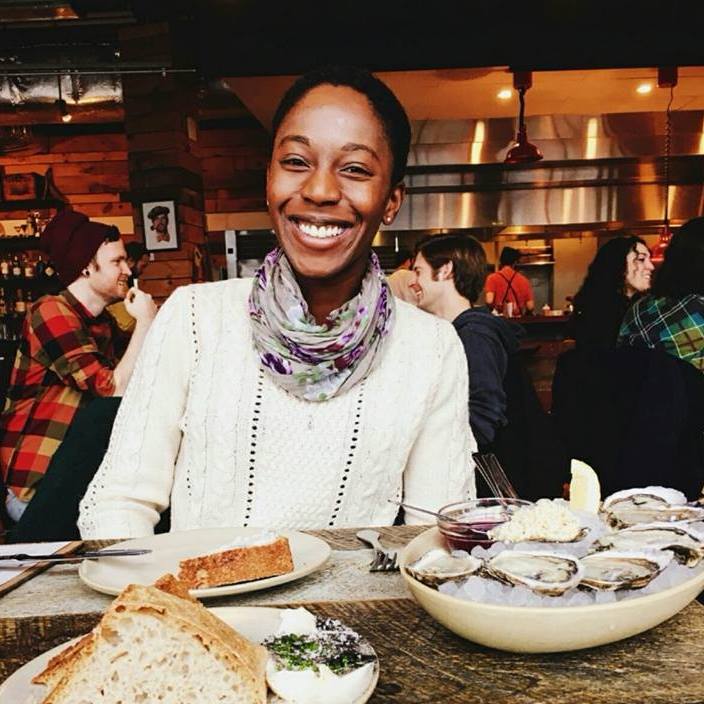 For several months now, I’ve been intrigued by the interconnections of memory, food, and identity. Identity making is a key point of interest for the socio-cultural anthropologist; those who use food as their primary mode of scholarship research would be amiss to overlook the power and significance that memories have on the construction of identity. Specifically, sense memories are an integral part of each and every one of our autobiographical recollections. It is a titanic understatement to say that we, as social researchers, leaders, and cultural curators, have so far undervalued the significance of the “lower tactile” senses and their value to our food experiences.
For several months now, I’ve been intrigued by the interconnections of memory, food, and identity. Identity making is a key point of interest for the socio-cultural anthropologist; those who use food as their primary mode of scholarship research would be amiss to overlook the power and significance that memories have on the construction of identity. Specifically, sense memories are an integral part of each and every one of our autobiographical recollections. It is a titanic understatement to say that we, as social researchers, leaders, and cultural curators, have so far undervalued the significance of the “lower tactile” senses and their value to our food experiences.
Aspects of our personal narratives are most intensely and emotionally recalled, and potentially re-learned, through memories associated with moments of taste, smell, sound, and touch. Our brain’s emotion centers are nearest to the brain’s taste and smell processing centers, so it is undeniable that our understandings of self are interrelated to these senses and that food experiences have great association with them. In Remembrance of Things Past, Marcel Proust (1981) reflects that remembering is not just reserved for thinking about past visual moments, but rather that remembering can be reliving and relearning events, places, and people of the past. Involuntary memories come up when we smell a scent, or like Proust, taste a particular flavor from our past. These involuntary memories help us to vividly recall not just the taste or smell, but also social associations, personal events, people, and relationships tied to the smell or taste. Our sense memories offer moments to reconsider our pasts, and so — as past is tied to the present — our current selves. This “Proustian Effect” and related phenomena are described by Verbeek and van Campen (2013) in the article “Inhaling Memories” where they share a plethora of examples of social workers, researchers, and artists who recognize sense memories as different from linguistic memory, and use it to aid in social and psychological healing and education of young and old. For example, the crispness, clarity, and emotional weight of smell memories has power to increase self worth in elderly at nursing homes by promoting social activity in discussion of sense memories. Sense and taste therapy can even help fight dementia and Alzheimer’s.
Of course, since smell memories can take us back to our youth, they also take us back to understandings, meanings, and dialogues of “home.” What stands out most to me on this topic is the idea that the metaphorical symbols that food smells and flavors take us back to often manifest cultural principles that we negotiate in our present time and spaces. This idea is expounded upon in David Suttons’ (2005) “Synesthesia, Memory, and the Taste of Home.” I could use the example of the mango fruit to help explain this concept. For me, smelling the peel of a mango, takes me back to eating mango in the backyard with my mom and sisters in San Diego, 1998. It also, immediately and somehow simultaneously, takes me back to the conversations I had with my mom about how she would eat mango with her brother in jungle trees growing up in the summers in Panama in the 1970s. My mother, in the 70’s with her brother, and the 90’s with my sisters and I, would eat the mango with her hands and teeth and nothing else. She would peel the skin off with her teeth, bite into the meat that surrounded the seed, and at the end, finally, put the shred of peeled skin halfway into her mouth and scrape the small layer of flesh that remained on the skin with the back of her front teeth. I learned to eat mango this way from watching her. Today, sometimes I use a knife and peeler, cut it into chunks, and eat it from a bowl with my hands or a fork. But every so often, when I eat it the way my mother taught me, the mango peel is right up close against my face, my olfactory nerves are charged, and the experience intimately forces me to smell the unique scent of the fruit and the peel in a deep way, both physically and emotionally. It is in the same strong, pleasurable and empowering feelings induced by food that are described in the works of Erdinç (2001) and Warren and Dennis (2005) (which I highly suggest). Not only do I suddenly recall images of my mother and sisters, but the scent of the peel makes me recall the value of the fruit that my mother taught us, the nutritional value that mango has, the value in eating every last bit we could scrape up off that peel, and so the cultural values of appreciation, gratefulness, and pleasure in food and the simple joys and satisfactions of life. Then I remember my heritage and my Panamanian roots. Really, and honestly, these are the things that the smell of mango peel takes me to. Each time I have mango in this way, I have current time and place negotiations with these meanings and understandings of my self, of my identity. As Sutton suggests, food really does participate in the recreation of our social bonds, cultural values, and personal understandings of self. Memories take us there.
Memories, food, and the senses are highly invaluable to the cultural anthropologist – in looking at this trio together in research, one can gain real, intimate perspectives of the demarcations and delineations of studied cultural identities. The philosophy and psychology behind food, sense, memory, and emotion are so deeply fascinating and should be more regularly considered in our field.
Bibliography
Erdinç, Ferda. 2001. Journeys through Smell and Taste: Home, Self, Identity. In Food and the Memory, edited by Harlan Walker, 91-99. Totnes, UK: Prospect Books.
Proust, Marcel. 1981. Remembrance of Things Past. New York: Random House.
Sutton, David. 2005. Synesthesia, Memory, and the Taste of Home. In The Taste Culture Reader: Experiencing Food and Drink, ed. Carolyn Korsmeyer, 304-316. New York, NY: Berg. Print.
Verbeek, Caro, and Cretien Van Campen. 2013. Inhaling Memories. The Senses and Society 8(2): 133-48.
Warin, Megan, and Simone Dennis. 2005. Threads of Memory: Reproducing the Cypress Tree through Sensual Consumption. Journal of Intercultural Studies 26(1-2): 159-170.
Cultural Transformation and the Authentic Sonoran Dog
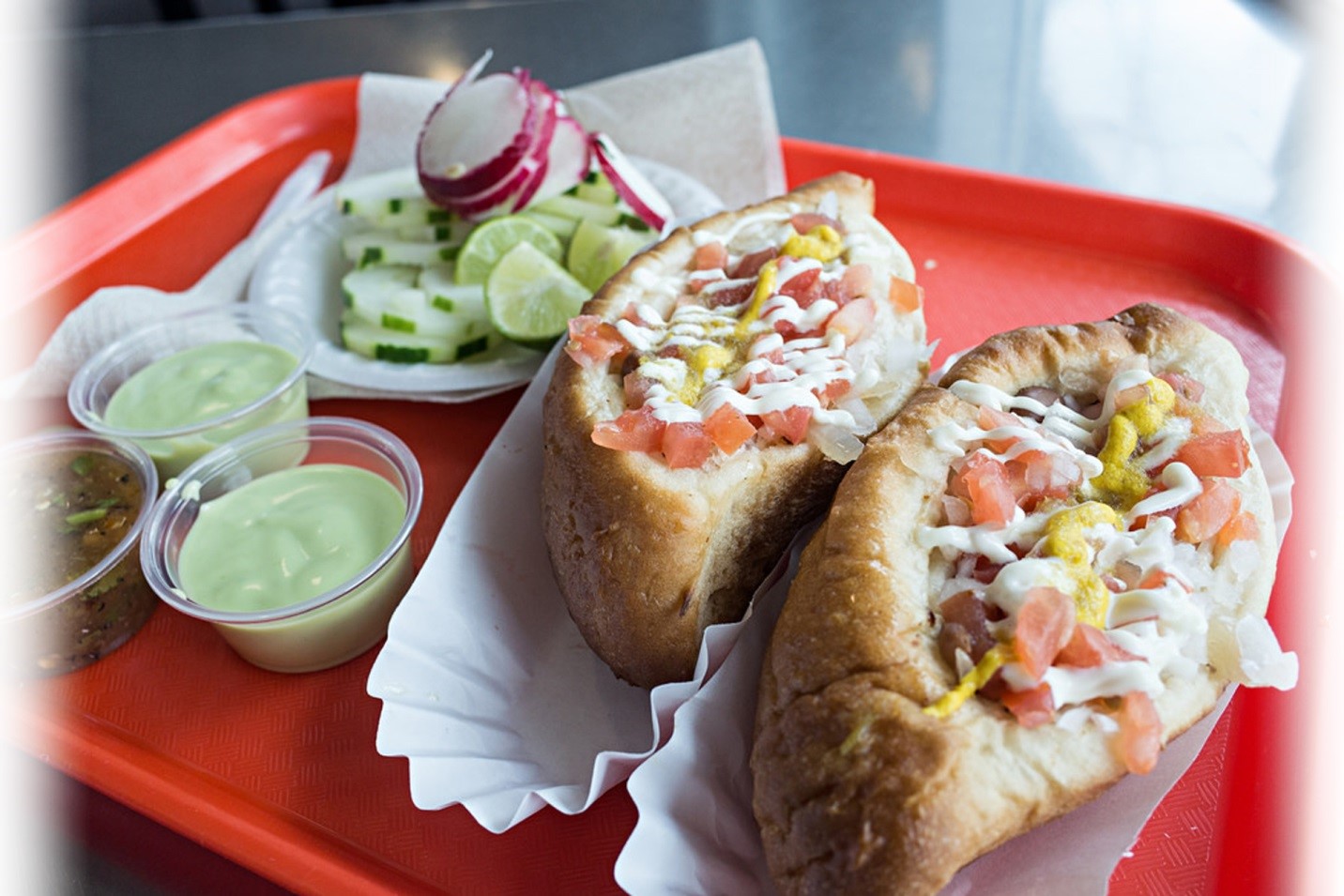
Our summer blog series “Perspectives from Anthropology of Food” presents work written by the students in the summer Anthropology of Food class (ML 641) in which they reflect on current issues, discuss assignments they have worked on, or address topics of particular interest to them. Today’s post is from Gastronomy student Karl Koch.
In this week’s classes, we’ve discussed the role of food in cultural transformation, which often led to the topics of authenticity, tradition, and “cuisine.” The gist is that cultures continue to adapt over time, spurred by new cultural, political, or economic stimuli, and foodways change as a result. Traditions and food rituals change, authenticity becomes more subjective, and cuisines are developed as intentionally put-forth products of culture, often for outsiders to be able to recognize. Many readers may be familiar with how formerly alien New World crops have become staples in Old World cultures in relatively recent history, like the example of Italian food and tomatoes, or Irish food and potatoes. The list goes on. If we held cultures to strict standards of tradition without the infusion of new ingredients and foodways, Southeast Asian foods would be without their signature spicy chili peppers. National Ethiopian cuisine would never have been created out of different regional foods and codified under the 19th-century reign of Empress Taytu, in part to emulate European monarchies and the elite foods they ate (McCann 2010: 64-99). The pre-contact Hawaiian luau would be nearly unrecognizable to contemporary residents of the island, whether ethnically Hawaiian or descended from the many immigrant groups that have come to call the islands home (O’Connor 2008: 167-168). People in the UK would not have the sugar to put in their tea!
The point is that cultures and their foodways are continuously changing. Nowhere was this more apparent to me than in my experience of living in Tucson, Arizona last year. Working at a small Catholic school on the predominantly Latinx south side of town, I was privileged to be exposed to many new foods through the generosity of others. Menudo, chilaquiles, the best pork lard-laden refried beans—these foods fit my expectations of traditional Mexican fare. But I also learned about the particularities of Sonoran foodways as apart from an overarching “Mexican cuisine.” For example, Sonoran tamales typically include a single green olive in the center, which is quite unusual compared to tamales from other regions of Mexico. But I was most intrigued by the so-called Sonoran dog, offered at the near-omnipresent street carts and food trucks. A bacon-wrapped hot dog in a fluffy, sweet bun, overloaded with beans, tomatoes, avocados, mustard, and mayonnaise, the Sonoran dog became a quick favorite of mine. But was this traditional? Was it authentic?
For the residents of Tucson and elsewhere in the Arizona-Sonora region, yes. True, the American ballpark-staple hot dogs may originate in the Austrian capital of Vienna (Wien in German, people from which are called Wieners). And true, mayonnaise may be some French-origin sauce that is now a typical sandwich condiment. But in this mash-up of cultures, you get a uniquely Mexican-American product. As Ted Robbins reports for NPR, the Sonoran dog and other borderland foods like fish tacos, chimichangas, and margaritas have spread both north and south (2009). One hundred years ago, tortilla chips would have been just as unfamiliar in Mexico City as in Chicago. To this extent, the Latinx people of Tucson may share more cultural practices and foodways with the people of southern Colorado than in Oaxaca in southern Mexico (see Carole Counihan’s A Tortilla is Like Life: Food and Culture in the San Luis Valley of Colorado, 2009).
With what I have learned through this course, I can now see how the people of Tucson navigate different identities and interact with multiple layers of overlapping cultures: Mexican, Sonoran, American, indigenous Tohono O’odham and Pascua Yaqui. As E. N. Anderson notes in his chapter on foods and borders in Everyone Eats, “food and foodways have been internationalizing for centuries” (2005: 208). So while a Sonoran dog may initially strike an outsider like myself as alien or jarring due to previously held notions of Mexican cuisine, the Sonoran dog is not any less authentic than menudo or chilaquiles. Yes, it is a hybridization of American and Mexican foodways, but the Sonoran dog is a perfect example of how cultures create something new out of different sources. Cultures and their foodways are dynamic and constantly transforming, especially in borderland cultures. Isn’t that a tradition unto itself?
Family Meals Then and Now
We continue with our summer blog series “Perspectives from Anthropology of Food” with this post from Adrian Bresler. This series presents work written by the students in the summer Anthropology of Food class (ML 641) in which they reflect on current issues, discuss assignments they have worked on, or address topics of particular interest to them.
In our “Anthropology of Food” class our evening discussion centered on family meals, on the definition of what constitutes a traditional family, and finally on how the overall perception of the family and the meals they eat has changed over time. We also focused on how these factors have been portrayed by the media in the United States over the past 40 to 50 years. The supporting presentation used in class juxtaposed a photo of the characters of TV’s Leave it to Beaver family against those of Modern Family. For those who are unfamiliar, in the former TV show, the Cleaver family of the 1950s comprised a working father, a stay-at-home mother and two school-age sons, all of whom sat down at the table together every night to eat a home-cooked meal and discuss daily events and family decisions. On the other hand, Modern Family, a currently running TV show, depicts three related families that live in the same vicinity: (i) a working couple with three children, (ii) a gay couple with an adopted child, and (iii) a non-traditional family consisting of an older, divorced man, a younger woman who is now married to him, both of them living with her son from her prior marriage, and the son that the couple has together.
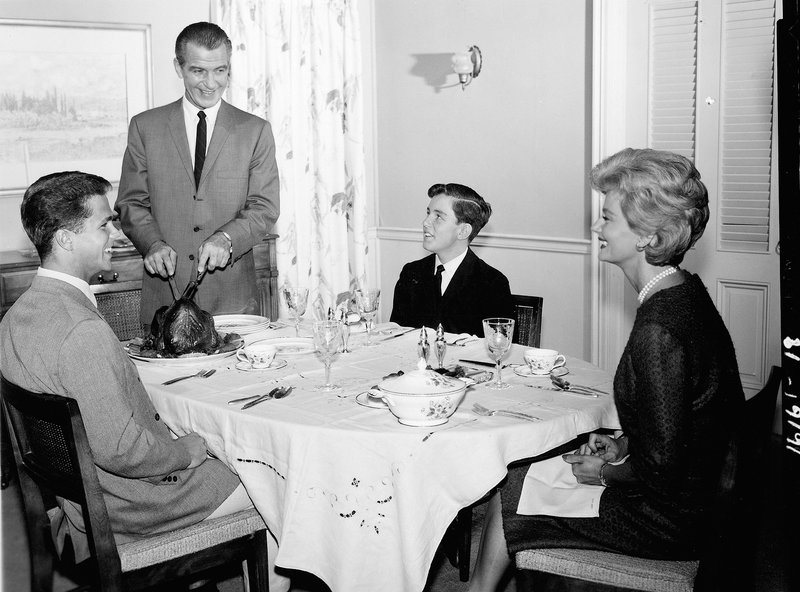
What is interesting is that despite the differences triggered by 50 years of cultural upheaval, these three families still sit down to eat together for celebrations. By doing so, they bring together those characters who bicker, those whose lifestyles are unconventional, and those who would not be connected to the rest in any way except for the fact that they are indeed ‘family’. While the kinds of discussions they have are different from the ones that take place in the Cleaver household—some triggered by their differences, others by the changes in society over the last 50 years—there are a lot of commonalities. Some things never change.

We went on to talk about the gradual shift in the way some people consider who else is to be included in their own families—those who are biologically related to them and those who are not, and the ones they share meals with and those with whom they do not. In our readings we learned about societies that view the family unit as “elastic” or “expandable” (Bloch 1999) in that close connections between people are formed and then strengthened by sharing food. Therefore, if you invite old friends to your house for dinner on Thanksgiving Day and treat them as if they are part of an extended family, on a day traditionally reserved for blood relatives, does biology really matter as long as the sharing continues? Can your definition of family expand for that day?
We also discussed the changing roles of various members of the family over the past 50 years. Since more women now work outside the home in demanding jobs, meals or portions of meals eaten at home may no longer be home-cooked but may be outsourced from local restaurants or supermarkets that offer prepared foods. In other families, gender roles have reversed and the other person prepares the meals. Perhaps family meals are eaten in restaurants more often. For yet others, no meal is eaten in favor of snacking or grazing during the day. The combinations are as endless as are the ways a family can be defined.
The way families share meals may have changed over the past 50 years and the sharing may be less frequent, but sitting down together to eat a meal still communicates the same messages of solidarity, shared values, and acceptance. Yes, families, however defined, can still argue about politics, money, religion, or baseball teams but the connection between people is reinforced by sharing food. The discussions in class has made me think about the way my own family has shared meals over the years; the memories of those people linger long after the meal is finished.
Works Cited:
Bloch, Maurice. 1999. Commensality and Poisoning. Social Research 66(1):133-149.
Course Spotlight: Readings in Food History
Dr. Megan Elias will teach Readings in Food History (MET ML 633) on Wednesday evenings during the fall 2017 semester, and has prepared this overview of the class.
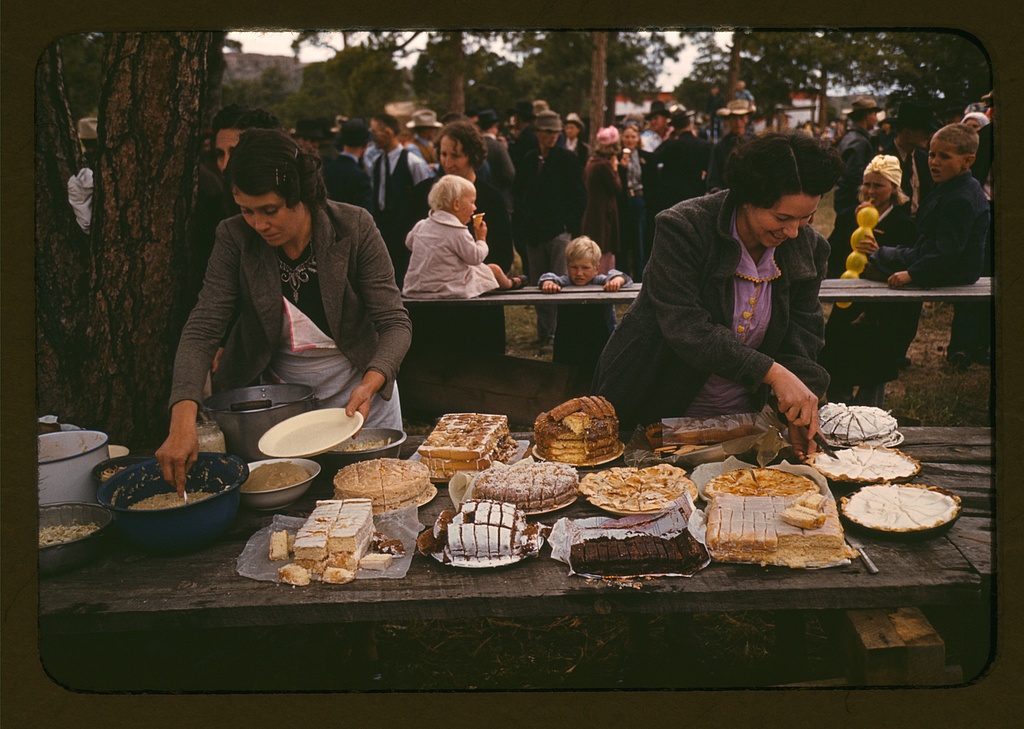
Every meal is a historical text, carrying messages about such things as global migrations, customs and trade routes. Because food has been both a constant and a catalyst in human histories many of the most important decisions made in the past depended on the need for sustenance or desire for new flavors. Paying close attention to food in world history helps to explain motives and strategies that shaped our world.

Through reading a selection of foundational and recent works in food history students will be able to identify and synthesize some of the major themes and arguments in the field. While dedicated food histories are a relatively new genre, food has always appeared in historical texts and these texts tell stories of their own that are sometimes left out of dominant narratives. We will consider some primary sources alongside our secondary texts to make sense of how food historians use their sources to build arguments. This work will help prepare students for Researching Food History, to be taught in the following semester.
Books we will be reading include the classic, Sweetness and Power by Sidney Mintz as well as more recent titles such as Food and Fantasy in Early Modern Japan by Eric Rath, Wine, Sugar and the Making of Modern France, by Elizabeth Heath, and To Live and Dine in Dixie by Angela Jill Cooley.
MET ML 633, Readings in Food History, will meet on Wednesday evenings from 6:00 to 8:45 pm, starting on September 6, 2017. Registration information can be found here.
Digital Field Work: A Call for Anthropological Research on Food’s Roles and Meanings in Social Media
Our summer blog series “Perspectives from Anthropology of Food” presents work written by the students in the summer Anthropology of Food class (ML 641) in which they reflect on current issues, discuss assignments they have worked on, or address topics of particular interest to them. Today’s post is from Gastronomy student Morgan Mannino.

My life as a Gastronomy student by night has started to seep into my role as a Senior Social Media Coordinator at America’s Test Kitchen by day. This summer in particular, I am enrolled in MET ML 641, Anthropology of Food, and have started to observe interactions that are happening online and to think about my role as a content producer through an anthropological lens. At face value, the world of social media and anthropological research may seem planets apart. And when one looks at what has been written, there is certainly a large gap between the traditional anthropological approach to what constitutes fieldwork and observation and what is happening online. However, many of the same concepts we’re exploring in Anthropology of Food—food as a system of communication, food being used to signify social relations and construct identity, feasting and commensality, etc.—are being enacted on social media. Thus, I am starting to see that there is a wealth of anthropological information that can be observed and analyzed through food’s role in social media. So, this is a call for anthropological fieldwork and observation to begin to address the value in applying an anthropological lens to food on social media. To start, I will present two examples that could make great research subjects.
This past year at America’s Test Kitchen we started a private Facebook group. We wanted to provide a place for our paying members to connect with each other, share their favorite ATK recipes, interact with cast members and staff, etc. A group like this (or really any food-focused Facebook group) could provide a wealth of information to an anthropologist. In our members group in particular, food is being used to express identity and status. One example of this is a thread where members have begun to post images of their kitchens and kitchen gadgets. These photos project members’ status as cooks—the more expensive or “professional” the gadgets or kitchen, the more they are perceived as better and more skilled home cooks to the group at large.
Food trends on social media are also rich places for studying the anthropology of food. The recent trend of “rainbow food” or “unicorn food” is a great example. Using Bourdieu’s concept of cultural capital, some questions to ask are: What does it mean when food transcends nourishment (or even taste-appeal or food-appeal) into pure spectacle? How is this trend gendered? How is status expressed through eating this food or even just taking pictures and sharing them? Here is a food map I created that begins to explore some of these questions about the trend of rainbow food on Instagram. In this map I used two variables: the y axis represents two poles of cultural capital, “high” vs. “low,” and the x axis represents two poles of material composition, “natural” vs. “artificial.” This is only one way to begin to analyze this trend, but already I was able to see how rainbow foods that are Instagrammed (the map also shows rainbow foods that aren’t Instagrammed to provide context) have high cultural capital, either because they are natural or, if they are artificial, their high cultural capital is derived from their exclusivity. This map help illustrates how rainbow food is a modern form of conspicuous consumption (on par with the sugar sculptures of Colonial England) and it is a fascinating example of identity and status being negotiated in food culture on social media today.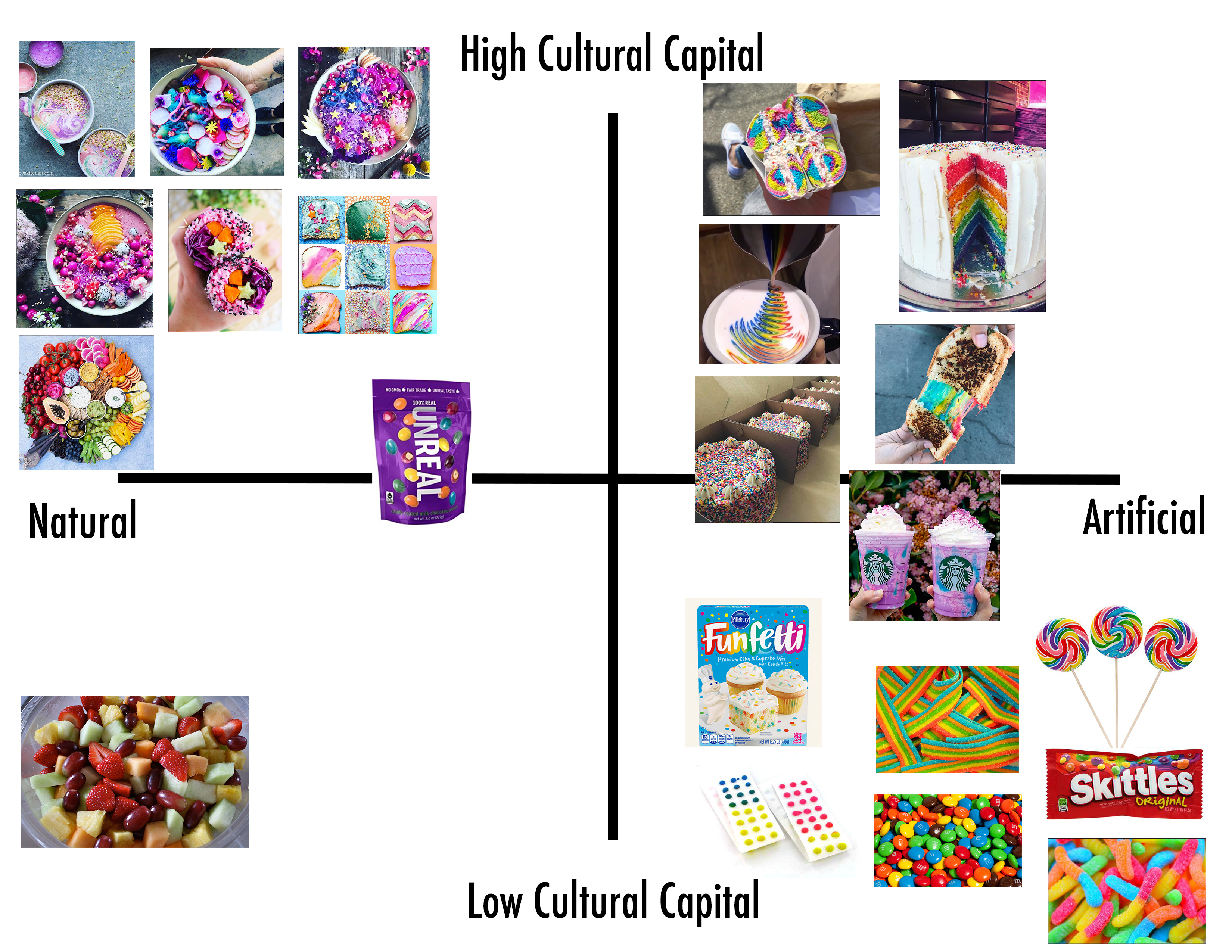
It’s also interesting, from the perspective of my work at America’s Test Kitchen, how meaning and identity are constructed through the rejection of food trends as well. Fans of America’s Test Kitchen in particular may shape their identity as cooks who are “above” food trends and instead look to mastering technical skills and/or iconic, classic recipes to inform and express their status as cooks instead.
In conclusion, there is wealth of information that can be learned by applying anthropological research practices to the ways we are expressing food meaning on social media. From private cooking groups to rainbow food, we’re negotiating identity, status, gender roles, and meaning through food images online.
A Father’s Day Perspective from Anthropology of Food
We continue with our summer blog series “Perspectives from Anthropology of Food” with this post from Gastronomy student Rebecca Nystrom. This series presents work written by the students in the summer Anthropology of Food class (ML 641) in which they reflect on current issues, discuss assignments they have worked on, or address topics of particular interest to them.
by Rebecca Nystrom
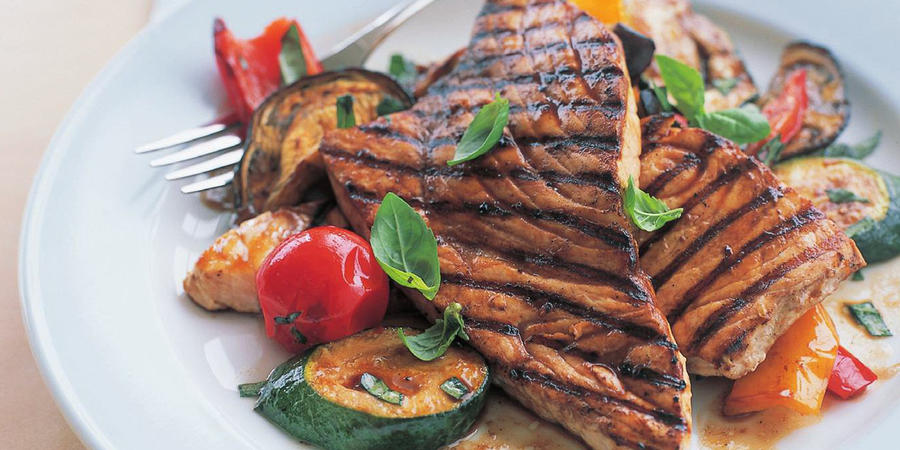
With Father’s Day only days away I’m sure many Americans are wondering what meal to prepare in order to encapsulate their appreciation for their special guy. Food is of course important to any holiday or large event but taking a step back from concerning ourselves over recipes, have you ever considered why? Food serves as a vehicle of expression, whether to a particular ethnic group, religious sect, or nationality. While these truths remain while feasting, commensal eating adds another layer of complexity. Commensal eating can serve to strengthen familiar or communal ties through various forms of cultural culinary expression bonding participants to particular culture. “This communal consumption therefore renders food a metaphor of we—the social group and often people as a whole” (Tierney and Ohnuki-Tierney 2012, 12). Communal eating additionally can serve to distinguish or create boundaries between socio-economic, cultural, or religious lines through the serving of unfamiliar items or meals that break a participant’s food rules or taboos. Who sits next to whom, the order of serving, the amount of food given, and the items served, can all denote aspects about family structure or larger cultural institutions (Nell 2015).

For this Father’s Day my family is preparing a surf and turf of steak and swordfish with grilled vegetables. My Dad loves to grill and eat outdoors, so we try to create a meal using the grill every Father’s Day. So while you scramble to find the perfect recipe for the father or husband in your life, pause to consider the importance of eating together and what this states about you as a family.
Works Cited
Nell, Cornelia A. 2015. Commensality and Sharing in an Andean Community in Bolivia. In Commensality: From Everyday Food to Feast, ed. Susanne Kerner, Cynthia Chou, and Morten Warmind, 165-176. New York: Bloomsbury.
Tierney, R. Kenji, and Emiko Ohnuki-Tierney. 2012. Anthropology of Food. In Oxford Handbook of Food History, ed. Jeffrey M. Pilcher, 117-134. New York: Oxford University Press.



